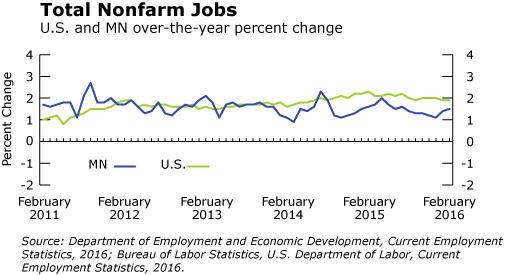by Nick Dobbins
March 2016
Monthly analysis is based on unadjusted employment data.
Employment in the Minneapolis-St. Paul MSA was up in February as the metro area added 7,579 jobs (0.4 percent). The growth was widespread as goods producers and service providers, as well as private and public sector employers, all added jobs. However, the lion’s share of the monthly growth came from the Government supersector, which added 5,506 jobs (2.2 percent). Most of that increase came in Educational Services at both the State (up 3,647 or 5.5 percent) and Local (up 2,034, 2.2 percent) levels. The private sector Educational and Health Services group saw similar growth, adding 4,647 jobs or 1.5 percent, with 3,346 of those jobs coming in Educational Services (up 7.4 percent). For the year, employment in the metro area grew by 33,571 (1.8 percent). The only supersector not to gain jobs was Information, which was largely unchanged on the year, losing two jobs (0.0 percent). Educational and Health Services added 12,499 jobs (4 percent), the largest growth both proportionally and in total jobs gained for the year. Leisure and Hospitality had the second largest proportional job growth, adding 4,219 jobs or 2.5 percent.
The Duluth-Superior MSA added 900 jobs (0.7 percent) in February. As was the case in other MSAs, the growth was driven by Government employment (up 865 or 3.4 percent), with growth in State and Local Governments leading the way (up 557 jobs or 7.9 percent and 300 jobs or 1.8 percent, respectively). Leisure and Hospitality chipped in as well, up 270 or 2.3 percent. A handful of supersectors in Duluth lost employment as well, the most notable of which was Trade, Transportation, and Utilities, which shed 210 jobs (0.8 percent). Annually, employment in the Duluth area was down 2,723 jobs (2 percent). It was the seventh straight month of over-the-year job loss for Duluth, a streak that dates back to August 2015. Mining, Logging, and Construction had the worst of it, down 928 jobs (10.9 percent) on the year, with Manufacturing close behind (down 718 or 9.7 percent). Leisure and Hospitality also took a hit, down 407 jobs or 3.2 percent, from February of 2015.
Employment in the Rochester MSA was off slightly in February, losing 58 jobs (0.1 percent) from January estimates. Most of that loss came from goods producers, who shed 430 jobs (2.9 percent) on the month, with losses of 323 (3 percent) in Manufacturing and 107 (2.8 percent) in Mining, Logging, and Construction. On the positive side, Professional and Business Services added 297 jobs (5.6 percent) in February, making a dent in longer term declines in that supersector. Annually, employment in the Rochester MSA remained up in February, supporting 2,740 (2.4 percent) more jobs than in February of 2015. Educational and Health Services remained the driving force behind the long term gains in Rochester, adding 2,186 jobs (4.8 percent) over the previous 12 months. Other areas of strength included Trade, Transportation, and Utilities (up 650 jobs, 3.7 percent) and Mining, Logging, and Construction (up 217 jobs, 6.1 percent).
The St. Cloud MSA added 969 jobs (0.9 percent) in February, ending its streak of three consecutive months of job losses. Government employers added 589 jobs (3.8 percent), and Educational and Health Services added 471 (2.2 percent), accounting for most of the gains. Annually, employment in St. Cloud was up by 2,660 (2.5 percent). Most supersectors added employment over the year, with the only significant drag on the total estimate coming from Manufacturing which dropped 223 jobs (1.5 percent).
Employment in the Mankato-North Mankato MSA was up by 628 jobs (1.1 percent) in February. Private employers added 209 jobs (0.4 percent) while Government employers added 419 (4.7 percent). All of that gain came from service providers, however, as goods producers lost 90 jobs (0.9 percent) on the month. Annually, employment in the MSA was up by 755 (1.4 percent). Goods producers lost employment here as well, down 269 jobs (2.8 percent). Government employment was also off for the year, down by 56 jobs (0.6 percent).
Employment in the Fargo-Moorhead MSA was up by 934 (0.7 percent) in February. As was common in February, Government employment led the way with 550 new jobs (up 3.1 percent), most of that growth coming in State and Local Governments. Professional and Business Services also had a strong February, adding 258 jobs (1.6 percent) for the month. Annually, the Fargo-Moorhead MSA added 2,797 jobs (2.1 percent). Professional and Business Services added 1,233 jobs (7.9 percent) over that time, the largest numerical or proportional growth for any supersector. The most notable decline came in Manufacturing which dropped 480 jobs (4.7 percent) for the year.
Employment in the Grand Forks-East Grand Forks MSA grew slightly in February, adding 172 jobs (0.3 percent) for the month, once again driven by growth in Government Employment. Losses in Leisure and Hospitality employment tempered the growth, with the supersector shedding 133 jobs (2.2 percent) in February. Annually, employment in the MSA was down by 178 jobs, with Government employers reversing their role and losing 358 jobs (2.4 percent) over the previous 12 months. Trade, Transportation, and Utilities also had significant declines, down 299 jobs (2.4 percent) on the year.
